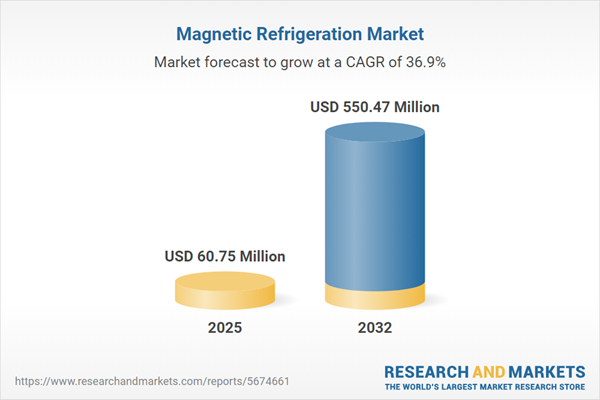Speak directly to the analyst to clarify any post sales queries you may have.
The magnetic refrigeration market is emerging as an attractive alternative for organizations aiming to advance sustainable cooling solutions that address operational efficiency and regulatory compliance. As businesses adapt to shifting standards and environmental goals, leaders are evaluating magnetic refrigeration to optimize organizational performance.
Market Snapshot: Magnetic Refrigeration Market Growth and Opportunity
Recent years have seen the magnetic refrigeration market transition from experimental applications toward broad commercialization. The sector is supported by evolving environmental policies and a strong drive toward sustainability. With a notable compound annual growth rate projected through 2032 and expanding commercial implementations, industries such as food processing and pharmaceuticals are adopting magnetic refrigeration systems to tackle rising energy costs and meet regulatory demands. Increased R&D, legislative alignment, and ongoing investments have accelerated market expansion and improved solution maturity. This growth is underlined by a shift toward energy-efficient infrastructure, positioning magnetic refrigeration as a pragmatic choice within global cooling strategies.
Scope & Segmentation: Key Areas in the Magnetic Refrigeration Market
This report delivers critical intelligence for C-suite and operational leaders by detailing vital segments driving the magnetic refrigeration market landscape:
- Application Areas: Utilized across industrial cooling, food and beverage supply chains, cold storage, HVAC systems, pharmaceutical logistics, transportation solutions, and residential cooling. Each sector requires customized approaches to sustainability and compliance.
- Technology Types: Includes active magnetic regenerators, elastocaloric and magnetostriction systems, thermoelastic designs, and both active and passive cooling strategies. These options enhance sector-specific deployment and integration capabilities.
- Material Types: Features gadolinium-based alloys, lanthanum iron silicon, manganese-based chemicals, and rare earth-alloy compounds. Appropriate material selection improves reliability and energy efficiency outcomes.
- Components: System performance relies on controllers, coils, regenerator beds, and heat exchangers. Selecting robust components supports longevity in demanding commercial and industrial settings.
- End Users: Organizations in chemical processing, food retail, pharmaceutical manufacturing, cryogenic operations, and HVAC services leverage magnetic refrigeration to strengthen compliance and sustainability initiatives.
- Temperature Ranges: Solutions accommodate needs ranging from cryogenic to ambient environments, allowing flexible integration for varied business demands.
- Regions: The Americas, Europe, Middle East and Africa, and Asia-Pacific. Market adoption is influenced by distinct regulatory frameworks and local business priorities in each territory.
- Key Companies: Leading market participants include Midea Group, Haier Smart Home, LG Electronics, Samsung Electronics, Danfoss, Mayekawa, Cooltech Applications, VacuumSchmelze, InnoHeAt, and Wuhan Tsinghua Magneto-Science & Technology, with each contributing sector expertise and innovation.
Key Takeaways for Senior Decision-Makers
- Magnetic refrigeration offers a path to replace conventional refrigerants, supporting strategic sustainability and compliance targets across multiple industries.
- Advancements in technology and material science enable solutions for specialized logistics, high-uptime production, and complex cooling scenarios.
- Data center and pharmaceutical manufacturing leaders are adopting magnetic refrigeration for improved efficiency and reduced operational risk in critical environments.
- Adoption rates vary globally, with North America and Europe influenced by stricter regulations and Asia-Pacific benefitting from collaborative manufacturing arrangements.
- Market competition among established providers and new entrants is improving solution reliability and reducing time-to-deployment for clients.
- Supply chain resilience and strategic partnerships are increasingly prioritized to mitigate disruptions due to regulatory or policy changes.
Tariff Impact: Shifting Supply Chains and Cost Structures
Upcoming US tariffs slated for implementation in 2025 are prompting companies to re-evaluate sourcing and manufacturing approaches. By strengthening local production capacity and fostering closer supplier relationships, leading organizations are enhancing supply chain resilience and minimizing operational disruptions in a changing regulatory environment.
Methodology & Data Sources
The analysis integrates secondary research, executive-level interviews, and specialized workshops. Findings are supported by peer-reviewed studies, market data sets, and validated corporate disclosures, establishing a foundation for actionable planning.
Why This Report Matters
- Supports confident investment and compliance decisions, facilitating robust supply chain and modular cooling strategy development.
- Enables benchmarking against evolving competitor strategies and regulatory shifts for effective organizational alignment.
- Offers guidance for organizations seeking to modernize cooling infrastructure while maintaining compliance and achieving sustainability goals.
Conclusion
Magnetic refrigeration supports the dual objectives of energy efficiency and regulatory compliance. Continued progress in technology and partnership models is set to enable responsible market expansion and greater adoption across key industries.
Additional Product Information:
- Purchase of this report includes 1 year online access with quarterly updates.
- This report can be updated on request. Please contact our Customer Experience team using the Ask a Question widget on our website.
Table of Contents
3. Executive Summary
4. Market Overview
7. Cumulative Impact of Artificial Intelligence 2025
Companies Mentioned
The companies profiled in this Magnetic Refrigeration market report include:- Midea Group Co., Ltd.
- Haier Smart Home Co., Ltd.
- LG Electronics Inc.
- Samsung Electronics Co., Ltd.
- Danfoss A/S
- Mayekawa Mfg. Co., Ltd.
- Cooltech Applications SAS
- VacuumSchmelze GmbH & Co. KG
- InnoHeAt B.V.
- Wuhan Tsinghua Magneto-Science & Technology Co., Ltd.
Table Information
| Report Attribute | Details |
|---|---|
| No. of Pages | 183 |
| Published | October 2025 |
| Forecast Period | 2025 - 2032 |
| Estimated Market Value ( USD | $ 60.75 Million |
| Forecasted Market Value ( USD | $ 550.47 Million |
| Compound Annual Growth Rate | 36.9% |
| Regions Covered | Global |
| No. of Companies Mentioned | 11 |









